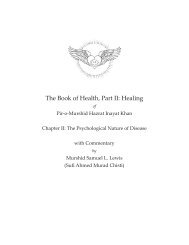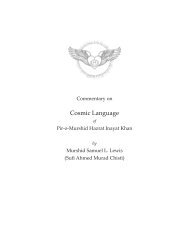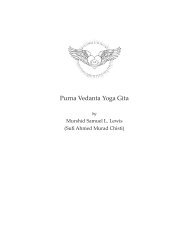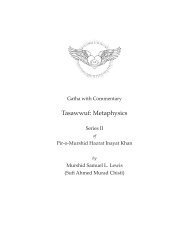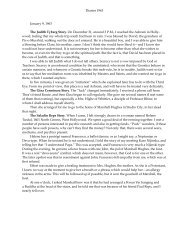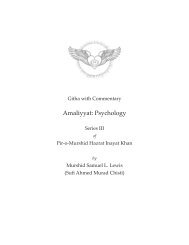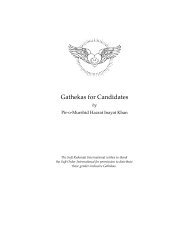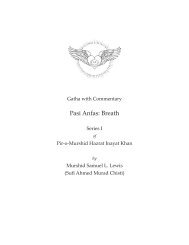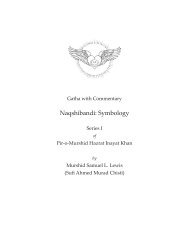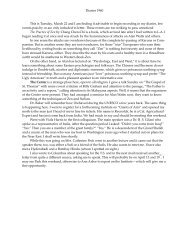Meditation on Salat
Meditation on Salat
Meditation on Salat
Create successful ePaper yourself
Turn your PDF publications into a flip-book with our unique Google optimized e-Paper software.
Toward the One, the Perfecti<strong>on</strong> of Love, Harm<strong>on</strong>y, and Beauty,the Only Being, United with All the Illuminated SoulsWho Form the Embodiment of the Master, the Spirit of Guidance.<str<strong>on</strong>g>Meditati<strong>on</strong></str<strong>on</strong>g> <strong>on</strong> <strong>Salat</strong>Papers for the JamiatNo.2The meditati<strong>on</strong> <strong>on</strong> <strong>Salat</strong> is to be performed each year at the opening of the Jamiat or at thebeginning of Summer School, or there may be two such meetings. It may also be used <strong>on</strong> the resumpti<strong>on</strong>of class work in centers where there are more than three pers<strong>on</strong>s in the Inner Circle at suchplaces where there is no Murshid. Where there is a Murshid, it shall be performed or omitted at theMurshid’s discreti<strong>on</strong>, but if omitted, another meditati<strong>on</strong> shall be substituted, the form and legend accordingto the directi<strong>on</strong> of the Murshid.There must be at least three pers<strong>on</strong>s at such a meditati<strong>on</strong> as some<strong>on</strong>e must act as Muezzin. TheMuezzin will hold a watch and g<strong>on</strong>g. If there is a Murshid or Pir-o-Murshid present, either that <strong>on</strong>ewill recite <strong>Salat</strong> or direct the Muezzin to do so, but in the absence of a Murshid, the Muezzin willlead.It is necessary that all mureeds be seated at least five minutes prior to the commencement ofthe service, even the Murshids. Therefore it is well that all be seated fifteen minutes prior to thehour, except the Murshid and Muezzin who should be in their places at least five minutes prior tothe hour. From 11 in the morning to no<strong>on</strong>, or from 5 to 6 in the afterno<strong>on</strong> are the best periods; otherwisefrom 3 to 4. These corresp<strong>on</strong>d to the hours of prayer in the Islamic religi<strong>on</strong>, but besides that thenature of these hours is naturally c<strong>on</strong>ducive to the purpose of the meditati<strong>on</strong>.One reas<strong>on</strong> for entering early is to permit the Murshid five minutes to regulate his own breath,to get it in rhythm for the spiritual rhythm of the Murshid is most important. The Muezzin mustalso carefully time his breath and note the interval in sec<strong>on</strong>ds of <strong>on</strong>e breath and three breaths. Theseshould be deep without being l<strong>on</strong>g, just of average length. The length of <strong>on</strong>e breath shall be called<strong>on</strong>e Pala, and the length of three breaths shall be termed 3 Palas.At three palas prior to the hour, the Muezzin strikes a g<strong>on</strong>g or some other instrument <strong>on</strong>ce,and exactly at the hour twice, leaving an interval or <strong>on</strong>e pala or <strong>on</strong>e breath between the two strokes,whereup<strong>on</strong> the leading Murshid or Muezzin says <strong>Salat</strong>, beginning with the first words:1. Most Gracious Lord, Master, Messiah and Savior of HumanityThe talibs assume a prayerful attitude and address Allah inwardly in the aspect of Rabb, orLord. This meditati<strong>on</strong> and each of the following meditati<strong>on</strong>s and c<strong>on</strong>centrati<strong>on</strong>s c<strong>on</strong>tinue two minutes,there being 30 such divisi<strong>on</strong>s or serbas, requiring exactly <strong>on</strong>e hour for the performance.At 3 palas prior to the 2 minutes, the g<strong>on</strong>g is struck <strong>on</strong>ce, and at the end of the two minutes, itis struck twice, with an interval of 1 pala between the two strokes whereup<strong>on</strong> the Leader c<strong>on</strong>tinuesas the sound dies away:1
<str<strong>on</strong>g>Meditati<strong>on</strong></str<strong>on</strong>g> <strong>on</strong> <strong>Salat</strong>2. We Greet Thee With All HumilityThe meditati<strong>on</strong> is “I am not,” which is fana, effacement. This form is effacement inAllah, fana-fi-lillah. At three palas prior to the next two minutes the g<strong>on</strong>g is again sounded, then atthe following minute interval the two g<strong>on</strong>gs with 1 pala time between them. This c<strong>on</strong>tinues throughthe hour and between the <strong>on</strong>e g<strong>on</strong>g and the two strokes the talibs watch their breath to make thenext adjustment.3. Thou Art the First Cause and the Last Effect,The Divine Light and the Spirit of Guidance, Alpha and OmegaThe idea is now baqa, that Allah is the Subsistent, the Only Being. This is the same principle asis in the beginning of the Invocati<strong>on</strong>, which is said by the Murshid or Leader immediately after enteringthe meditati<strong>on</strong> hall, therefore somewhat prior to the <str<strong>on</strong>g>Meditati<strong>on</strong></str<strong>on</strong>g> <strong>on</strong> <strong>Salat</strong>. In other words, afterc<strong>on</strong>sidering: “I am not,” <strong>on</strong>e c<strong>on</strong>siders: “Thou art.”4. Thy Light Is in All Forms, Thy Love in All BeingsThis is Nuri Mohammed, which is not to be c<strong>on</strong>fused with any particular being, although itpresents the Primal Adam. This may be c<strong>on</strong>sidered as God in the highest aspect of Thought, as opposedto Feeling. Besides that, after the c<strong>on</strong>siderati<strong>on</strong> of “I am not,” the negati<strong>on</strong> of the first pers<strong>on</strong>,comes “Thou art,” the affirmati<strong>on</strong> of the sec<strong>on</strong>d pers<strong>on</strong>, or the opposite of the first pers<strong>on</strong>, and theseare united in the third pers<strong>on</strong>, which idea is expressed in the syllable HU. But God wishes to becomeknown also, and so all forms and beings arise from the Nuri Mohammed, and these are nextc<strong>on</strong>sidered:5. In a Loving MotherC<strong>on</strong>centrate <strong>on</strong> a loving mother, either <strong>on</strong>e’s own or some<strong>on</strong>e else’s who, because of motherhood,has radiated love and life to her children, and perhaps to others. A living mother is preferableto <strong>on</strong>e who has entered a higher plane, and this holds true of the next four subjects, <strong>on</strong>e in the fleshis preferred.6. In a Kind FatherC<strong>on</strong>centrate <strong>on</strong> some father, who because of his being a father, has been kind-hearted to hischildren and to others.7. In an Innocent ChildC<strong>on</strong>centrate <strong>on</strong> a child who has preserved angelic qualities. Do note c<strong>on</strong>centrate <strong>on</strong> any<strong>on</strong>ewho is sick or to help him, but c<strong>on</strong>centrate <strong>on</strong> <strong>on</strong>e who is making others happy. In these c<strong>on</strong>centrati<strong>on</strong>sthe idea is to draw a sympathetic current, so <strong>on</strong>e can imbibe through the breath the same desirablequalities as manifest in such pers<strong>on</strong>s and at the same time recognize and realize that all thesedesirable qualities are aspects of Allah, though veiled.2
<str<strong>on</strong>g>Meditati<strong>on</strong></str<strong>on</strong>g> <strong>on</strong> <strong>Salat</strong>8. In a Helpful FriendC<strong>on</strong>centrate <strong>on</strong> <strong>on</strong>e who has helped you or has helped others. Do not c<strong>on</strong>centrate <strong>on</strong> <strong>on</strong>e needinghelp, or who is sick or invalided. Do not c<strong>on</strong>centrate <strong>on</strong> any Murshid or Sheikh unless a Pir-o-Murshid is present, but it is permissible to c<strong>on</strong>centrate <strong>on</strong> any mureed present or not present. Inother words, for the 5 th , 6 th , 7 th , and 8 th divisi<strong>on</strong>s each has his own c<strong>on</strong>centrati<strong>on</strong>.9. In an Inspiring TeacherThis is Tasawwuri Murshid. In the presence of the Pir-o-Murshid all unite in c<strong>on</strong>centrating <strong>on</strong>the Pir-o-Murshid and the Pir c<strong>on</strong>centrates <strong>on</strong> the previous Pir-o-Murshid. In the absence of a Pir-o-Murshid, all present c<strong>on</strong>centrate <strong>on</strong> the Murshid who c<strong>on</strong>centrates <strong>on</strong> the Pir-o-Murshid. If there isneither Pir-o-Murshid nor Murshid present, the Khalif or Leader opens the meeting in the name ofa Murshid who is the subject of Tasawwuri. One does not c<strong>on</strong>centrate <strong>on</strong> a Khalif or Sheikh in thisserba.10. Allow Us to Recognize Thee in All Thy Holy Names and FormsAllah has first been recognized as Rabb; as Baqa, the Only Being which is His c<strong>on</strong>diti<strong>on</strong> calledAhadiat, and as Nuri Mohammed, or his c<strong>on</strong>diti<strong>on</strong> called Wahdaniat. These are hidden aspects.Then came the c<strong>on</strong>centrati<strong>on</strong> <strong>on</strong> the manifested qualities of Allah in the 5 th , 6 th , 7 th , and 8 th and 9 th secti<strong>on</strong>sand now is the transference to the manifested forms of Allah as distinguished from qualities.At the same time all form a Single Embodiment, but the mind may bring a divisi<strong>on</strong>; otherwiseAllah could not be recognized in form, <strong>on</strong>ly above form. It is the purpose of mind to understandAllah is in form that the mind can comprehend, besides being in Essence which the mind cannotc<strong>on</strong>ceive.11. As RamaTry to visualize Rama as being present in some form and remaining in the <str<strong>on</strong>g>Meditati<strong>on</strong></str<strong>on</strong>g> Hall. Tryalso to feel his presence. The better <strong>on</strong>e can visualize, the more he enters Tasawwuri Rama.12. As KrishnaThe same directi<strong>on</strong> is followed for Krishna. There will be a difference in feeling and the talibshould try to remember the experiences, but the feeling is the most important. This makes it possibleto draw the spiritual qualities and faculties from the Holy Ones which is the purpose of this service.However, notes are not copied until after the service.13. As Shiva, 14. As Buddha, 15. Let Us Know Thee as Abraham, 16. As Solom<strong>on</strong>,17. As Zarathustra, 18. As Moses, 19. As Jesus, 20. As MohammedThe same directi<strong>on</strong>s c<strong>on</strong>tinue as the names of each of the world Teachers is called. When thefirst g<strong>on</strong>g is sounded remove the thought of the other, but retain any visi<strong>on</strong>, for sometimes they remainin visi<strong>on</strong> as it is true that they enter the <str<strong>on</strong>g>Meditati<strong>on</strong></str<strong>on</strong>g> Hall. Wherever the accommodati<strong>on</strong> is madefor the Holy Being, there is he.3
<str<strong>on</strong>g>Meditati<strong>on</strong></str<strong>on</strong>g> <strong>on</strong> <strong>Salat</strong>When the two strokes are sounded and the name read, visualize the character as the words of<strong>Salat</strong> are spoken. In this way the great spirituality and holiness comes to <strong>on</strong>e through the chain ofthe Hierarchy which is most important.21. And in Many Other Names and Forms Known and Unknown to the World.Now c<strong>on</strong>centrate up<strong>on</strong> other world teachers and the chain of Sufi Murshids. Sometimes theywill come in visi<strong>on</strong> or feeling, but the talib remains passive to God; recognize God first and form asan aspect of God.22. We Adore Thy Past, Thy Presence Deeply Enlightens Our Being,and We Look for Thy Blessing in the Future.The c<strong>on</strong>centrati<strong>on</strong> is now <strong>on</strong> the Unity of all the Holy Ones in Chain, <strong>on</strong> the uni<strong>on</strong> of theMurshids, present in spirit or form with them, and <strong>on</strong> each <strong>on</strong>e’s individual uni<strong>on</strong> with the Chainthrough the Murshids. This is something like the Invocati<strong>on</strong>, but with <strong>on</strong>e difference—that is, thepurpose is here to receive individual help and inspirati<strong>on</strong> through the Chain.23. O Messenger, Christ, Nabi, The Rassoul Of God!Thou Whose Heart C<strong>on</strong>stantly Reaches Upward, Thou Comest <strong>on</strong> Earth With a MessageThis c<strong>on</strong>centrati<strong>on</strong> is <strong>on</strong> our Holy Murshid Hazrat Inayat Khan, who has united in his pers<strong>on</strong>alityall the mysteries of all the Holy Ones of the past, and transmitted this teaching and their perfecti<strong>on</strong>to us.24. As a Dove From Above When Dharma DecayethThe c<strong>on</strong>centrati<strong>on</strong> is <strong>on</strong> a Dove, which may be felt or perceived through the breath, with thefeeling of uni<strong>on</strong> with that Dove. This is to enable each talib also to become a Message bearer andthus serve the Message. First the Messenger is c<strong>on</strong>sidered and then the transmissi<strong>on</strong> of the Messageand then the becoming of the Message which is the next c<strong>on</strong>centrati<strong>on</strong>:25. And Speakest the Word That Is Put Into Thy MouthThese three c<strong>on</strong>centrati<strong>on</strong>s are fana-fi-Rassoul, absorpti<strong>on</strong> <strong>on</strong>to the qualities of the worldteacher, first in form as himself, next in the symbol of the Dove and now c<strong>on</strong>centrate with the SufiSymbol <strong>on</strong> the t<strong>on</strong>gue. This enables <strong>on</strong>e to think Holy Thoughts and speak sacred words.26. As the Light Filleth the Crescent Mo<strong>on</strong>One visualizes a crescent mo<strong>on</strong> in the forehead filling or being filled with light.27. Let the Star of the Divine Light Shining in Thy HeartBe Reflected in the Hearts of Thy DevoteesOne visualizes a star of light in <strong>on</strong>e’s own heart, and feels it radiating light and love. These lastthree c<strong>on</strong>centrati<strong>on</strong>s are c<strong>on</strong>nected, the <strong>on</strong>e in the mouth representing the purificati<strong>on</strong> of the physi-4
<str<strong>on</strong>g>Meditati<strong>on</strong></str<strong>on</strong>g> <strong>on</strong> <strong>Salat</strong>cal body, the mo<strong>on</strong> for the mental purificati<strong>on</strong> and this for the purificati<strong>on</strong> of the heart. These are theblessings with breath, water and blood referred to in the New Testament.28. May the Message of God Reach Far and Wide, IlluminatingOne now c<strong>on</strong>centrates as being within the Sufi Symbol. Feel <strong>on</strong>e’s heart as the heart, and feelthe star and crescent there, and the wings extending bey<strong>on</strong>d <strong>on</strong>e, that <strong>on</strong>e is radiating light. Thisis the c<strong>on</strong>tinuati<strong>on</strong> and completi<strong>on</strong> of the three others, and as they represent the c<strong>on</strong>centrati<strong>on</strong> forbody, mind, and heart, this may be called the c<strong>on</strong>centrati<strong>on</strong> of the soul.29. And Making the Whole Humanity as One Single BrotherhoodNow a c<strong>on</strong>centrati<strong>on</strong> is necessary to bring all the mureeds together who have been attuningindividually to God and the Holy Spirit. This c<strong>on</strong>centrati<strong>on</strong> is fana-fi-Adam, which begins by feelinguni<strong>on</strong> with those above, then with those doing the same work—<strong>on</strong>e’s fellow mureeds—and this initself accomplishes uni<strong>on</strong> with the whole humanity.30. In the Fatherhood of GodBut the last c<strong>on</strong>centrati<strong>on</strong> perfects Attributes, Sifat, and now the return to Allah is necessary, asqualities come from Allah and in the final c<strong>on</strong>centrati<strong>on</strong> <strong>on</strong>e returns to the first idea, making a completi<strong>on</strong>and expressing the words of Qur’an, “From Allah we all come, and to Him we all return.”This last c<strong>on</strong>centrati<strong>on</strong> c<strong>on</strong>tinues for the full two minutes to the hour when the Muezzin strikestwice, with the usual interval of <strong>on</strong>e pala between the strokes. This completes the meditati<strong>on</strong>, but no<strong>on</strong>e rises for five minutes. During those five minutes the talibs will come from their meditati<strong>on</strong> andthose who have messages or notes or inspirati<strong>on</strong>s may begin to write them at <strong>on</strong>ce.At the end of five minutes the g<strong>on</strong>g is again struck twice, the Pir-o-Murshid (or Leader) andthe Muezzin immediately leave, and then those mureeds who have nothing to record or who havecompeted their records. The others remain, 15 minutes being allotted to this purpose, during whichtime no <strong>on</strong>e may enter the <str<strong>on</strong>g>Meditati<strong>on</strong></str<strong>on</strong>g> Hall for any reas<strong>on</strong> whatsoever. The Holy Ones may be inmeditati<strong>on</strong>.If for spiritual reas<strong>on</strong>s pers<strong>on</strong>s stay l<strong>on</strong>ger, the period is extended. It is well not to use the roomfor any purpose except meditati<strong>on</strong> until the next hour is completed, unless Zikr be performed at thediscreti<strong>on</strong> of the Pir-o-Murshid or Murshid, during that time.A res<strong>on</strong>ant g<strong>on</strong>g is the best instrument but a cymbal may be used, or a drum specially devotedfor sacred purposes or even a vina or lute if there is a competent musician to act as Muezzin, but ag<strong>on</strong>g or cymbal is always safe.This meditati<strong>on</strong> is detached from all other services except perhaps Zikr, so for the whole hourprior to its performance no <strong>on</strong>e should enter the Hall except for meditati<strong>on</strong> or Zikr. This means threehours preservati<strong>on</strong> of spiritual atmosphere.There should be no healing services that day or the day prior, but there may be two daysbefore or <strong>on</strong> the day after. Neither do Khifayats and Shifayats attend this <str<strong>on</strong>g>Meditati<strong>on</strong></str<strong>on</strong>g>. In <strong>Salat</strong> <strong>on</strong>e5
<str<strong>on</strong>g>Meditati<strong>on</strong></str<strong>on</strong>g> <strong>on</strong> <strong>Salat</strong>receives from God in Name and Form and gives to God above Name and Form, while in healing <strong>on</strong>ereceives from spirit above Name and Form and gives to Name and Form. The Khatum and not <strong>Salat</strong>is especially for those <strong>on</strong> the healing path.Both of these aspects are united in Saum where <strong>on</strong>e receives from God above Name and Formand gives to God above Name and Form. Saum is therefore not used in C<strong>on</strong>centrati<strong>on</strong>, because C<strong>on</strong>centrati<strong>on</strong>is c<strong>on</strong>nected with names and forms. Saum may be used as meditati<strong>on</strong> for all mureeds, butin Saum it is the movements which are important, while in <strong>Salat</strong> it is the thought movements whichhave value corresp<strong>on</strong>ding with the physical movements of Saum.6



